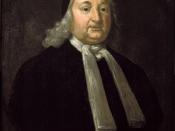In a letter to William Lloyd Garrison dated November 24, 1863, John Greenleaf Whittier comments on his joy over the "prospect of the speedy emancipation of the slaves of the United States". He also declares "I set a higher value on my name as appended to the Antislavery Declaration of 1833 than on the title-page of any book". Whittier, a Quaker, farmer, and poet had long been involved with the abolitionist movement and many times had expressed his opinions on the subject of slavery. In his poem, The Farewell Of a Virginia Slave Mother to Her Daughters Sold into Southern Bondage, Whittier describes the plight faced by a Negro family separated due to the abominations of slavery. The Farewell, first published in 1838, eloquently conveys the anguish of a slave mother:
There no mother's eye is near them,
There no mother's ear can hear them;
Never, when the torturing lash
Seams their back with many a gash,
Shall a mother's kindness bless them,
Or a mother's arms caress them.
Gone, gone,--sold and gone,
To the rice-swamp dank and lone,
From Virginia's hills and waters;
Woe is me, my stolen daughters!
Whittier and his contemporaries were not the originators of the abolitionist movement however. Early in this country's history many religious, social, and political leaders sewed the seeds of abolition. From the early days of the Puritans to the time of the American Revolutionary War, men and women of great conscience gathered to express their outrage at a morally and ethically corrupt institution.
Samuel Sewall, a wealthy merchant and printer, wrote what was considered to be the first anti-slavery piece published in the colonies. Appointed in 1691 to the General Council, Sewall was selected to serve as one of nine judges on the Salem witchcraft trials by Massachusetts Governor William Phips.


